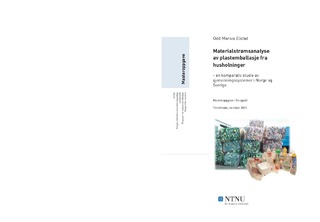Materialstrømsanalyse av plastemballasje fra husholninger - en komparativ studie av gjenvinningssystemer i Norge og Sverige
Master thesis
Permanent lenke
http://hdl.handle.net/11250/242599Utgivelsesdato
2005Metadata
Vis full innførselSamlinger
Sammendrag
The European Union has made directive 94/62/EC regarding collection, recycling and energy recovery of plastic packaging. Both Norway and Sweden have to comply with those directives, and they have made their own national targets on the basis of these directives. The goal is to send 30 % of all potential plastic waste to material recycling each year. In attempt to fulfill these EU requirements, both countries have built-up a system for collection, material recycling and energy recovery of their plastic packaging. Both systems are quite similar in nature, but there are some individual differences. First; in Sweden the sorting takes place in two steps; in Norway only one. Second; Norway sends large fractions of plastic waste to chemical recycling and call it material recycling, something that is not allowed in Sweden.
Do these systems work in the way the governments want they to do, and do they meet their targets? Do one system in some ways work better than the other? With the use of Material Flow Accounting (MFA), both systems have been studied to see if they fulfill their goals, and identify improvement potentials.
Sweden produces more plastic packaging waste than Norway. Sweden has a plastic waste potential of 309 031 tonnes from households, opposed to 84 860 tonnes in Norway. Of the amounts that are collected, either through a plastic collection system or through mixed-waste, only 6,5 % of Polypropylene packaging in Norway and 2,9 % in Sweden actually goes to material recycling. Both countries count the amount collected as the amount recycled. Norway will still recycle only 6,5 %, but Sweden increase to 8,1 %.
